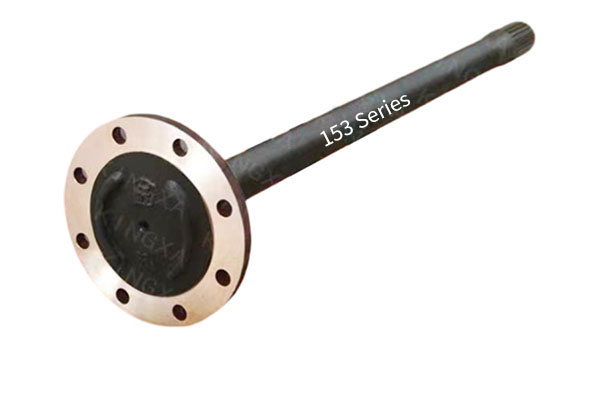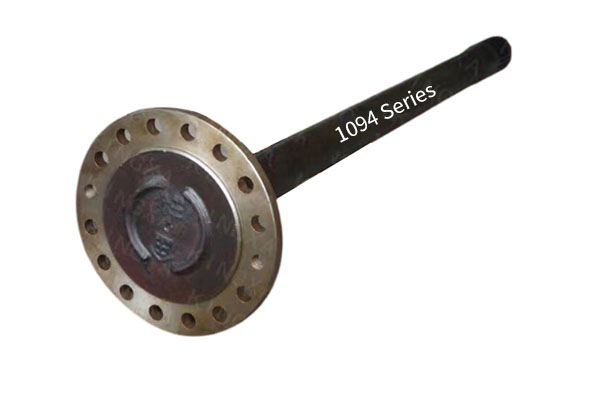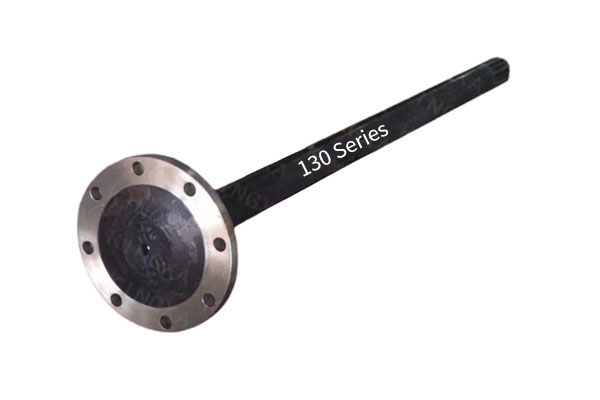How to design a Light Vehicle Rear Axle Half Shaft to balance lightweight and strength requirements?
Release Time : 2024-10-18
When designing a Light Vehicle Rear Axle Half Shaft, balancing lightweight and strength requirements is a key challenge.
1. Material selection
High-strength steel: Select high-strength steel (such as high-strength low-alloy steel, HSLA), which can reduce material usage while maintaining strength and achieve lightweight.
Aluminum alloy: Aluminum alloy has a high strength-to-weight ratio and can significantly reduce the weight of the half shaft, but may require additional surface treatment (such as anodizing) to improve corrosion resistance.
Titanium alloy: Although titanium alloy has a high cost, it has an extremely high strength-to-weight ratio and excellent corrosion resistance, and is suitable for models with extremely high lightweight requirements.
2. Structural design optimization
Hollow design: The hollow half shaft design uses a reduced outer diameter but an increased inner diameter, which can effectively reduce weight while maintaining sufficient strength and rigidity. Hollow shafts can be made by internal pressure casting or welding.
Non-uniform wall thickness: Design different wall thicknesses in different parts, that is, increase the wall thickness in the stress concentration area to improve strength, and reduce the wall thickness in the area with less load to reduce weight.
Special-shaped cross-section: Rectangular, elliptical or other non-circular cross-section designs are used. These cross-sections can provide higher bending strength and torsional stiffness with the same amount of material.
3. Surface treatment
Strengthening treatment: Such as surface carburizing and nitriding treatment, etc., can improve the surface hardness of the half-axle, enhance wear resistance and fatigue resistance.
Coating technology: Such as thermal spraying, galvanizing, ceramic coating, etc., can improve the corrosion resistance and surface hardness of the half-axle and extend the service life.
4. Manufacturing process
High-pressure casting: The high-pressure casting process can be used to manufacture half-axles with complex shapes and uniform wall thickness, reduce material waste and improve strength.
Heat treatment: Through appropriate heat treatment processes (such as quenching and tempering), the microstructure of the material can be optimized and the strength and toughness of the half-axle can be improved.
Precision machining: Through precision machining technology (such as CNC machine tools, laser welding, etc.), ensure the precise matching of each component and improve the stability and strength of the overall structure.
5. Finite element analysis (FEA)
Stress analysis: Use finite element analysis software to simulate the stress distribution of the half shaft under different working conditions, optimize the design, and ensure the strength and stability under different load conditions.
Fatigue analysis: Through fatigue analysis, evaluate the performance of the half shaft after long-term use to prevent fracture or other failures caused by fatigue.
6. Test verification
Static test: Through static load test, verify the strength and stiffness of the half shaft under the maximum design load.
Dynamic test: Through dynamic load test, simulate the vibration and impact in actual use to verify the fatigue life and durability of the half shaft.
By optimizing the performance of materials, designing a reasonable structure, adopting advanced manufacturing processes and surface treatment, and using advanced analysis tools, the lightweight and strength requirements of Light Vehicle Rear Axle Half Shaft can be taken into account. This can not only improve the fuel economy and handling performance of the vehicle, but also significantly improve the service life and safety of the components.
1. Material selection
High-strength steel: Select high-strength steel (such as high-strength low-alloy steel, HSLA), which can reduce material usage while maintaining strength and achieve lightweight.
Aluminum alloy: Aluminum alloy has a high strength-to-weight ratio and can significantly reduce the weight of the half shaft, but may require additional surface treatment (such as anodizing) to improve corrosion resistance.
Titanium alloy: Although titanium alloy has a high cost, it has an extremely high strength-to-weight ratio and excellent corrosion resistance, and is suitable for models with extremely high lightweight requirements.
2. Structural design optimization
Hollow design: The hollow half shaft design uses a reduced outer diameter but an increased inner diameter, which can effectively reduce weight while maintaining sufficient strength and rigidity. Hollow shafts can be made by internal pressure casting or welding.
Non-uniform wall thickness: Design different wall thicknesses in different parts, that is, increase the wall thickness in the stress concentration area to improve strength, and reduce the wall thickness in the area with less load to reduce weight.
Special-shaped cross-section: Rectangular, elliptical or other non-circular cross-section designs are used. These cross-sections can provide higher bending strength and torsional stiffness with the same amount of material.
3. Surface treatment
Strengthening treatment: Such as surface carburizing and nitriding treatment, etc., can improve the surface hardness of the half-axle, enhance wear resistance and fatigue resistance.
Coating technology: Such as thermal spraying, galvanizing, ceramic coating, etc., can improve the corrosion resistance and surface hardness of the half-axle and extend the service life.
4. Manufacturing process
High-pressure casting: The high-pressure casting process can be used to manufacture half-axles with complex shapes and uniform wall thickness, reduce material waste and improve strength.
Heat treatment: Through appropriate heat treatment processes (such as quenching and tempering), the microstructure of the material can be optimized and the strength and toughness of the half-axle can be improved.
Precision machining: Through precision machining technology (such as CNC machine tools, laser welding, etc.), ensure the precise matching of each component and improve the stability and strength of the overall structure.
5. Finite element analysis (FEA)
Stress analysis: Use finite element analysis software to simulate the stress distribution of the half shaft under different working conditions, optimize the design, and ensure the strength and stability under different load conditions.
Fatigue analysis: Through fatigue analysis, evaluate the performance of the half shaft after long-term use to prevent fracture or other failures caused by fatigue.
6. Test verification
Static test: Through static load test, verify the strength and stiffness of the half shaft under the maximum design load.
Dynamic test: Through dynamic load test, simulate the vibration and impact in actual use to verify the fatigue life and durability of the half shaft.
By optimizing the performance of materials, designing a reasonable structure, adopting advanced manufacturing processes and surface treatment, and using advanced analysis tools, the lightweight and strength requirements of Light Vehicle Rear Axle Half Shaft can be taken into account. This can not only improve the fuel economy and handling performance of the vehicle, but also significantly improve the service life and safety of the components.







